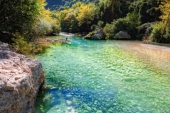Homepage > Learning Science through Nature > Geographical Areas
GEOGRAPHICAL AREAS

PICTURES
DRAWINGS
VIDEO
|
Acheron river Acheron river springs from the mountainous area of the prefecture of Ioannina and after a route of 64km it reaches Ionian sea, creating a lot of ecosystems which provide shelter to a lot of animals and plants. The area strait and estuary of Acheron is one of 18 natural regions recognized as the most remarkable in whole Epirus .the area occupies a great extent of land of 4630 acres and it is so important both in European (SCI code GR2140001) and National level ( Natura 2000 code GR21200080) due to its distinguishing features and its biodiversity. The water of Acheron irrigate almost 85.000 acres. |
|
Necromanteion Necromanteion was devoted to Hades and Persephone. According to tradition, it was located on the banks of the Acheron river in Epirus, near the ancient city of Ephyra the capital of ancient Thesprotia. This site was believed to be the door to Hades, the realm of the dead. The site is at the meeting point of the Acheron, Pyriphlegethon and Cocytus rivers and was believed to flow through and water the kingdom of Hades. The meaning of the names of the rivers has been interpreted to be \"joyless\", \"burning coals\" and \"lament.\" The word Necromanteion means “Oracle of Death”. The ritual of the Necromanteion involved elaborate ceremonies wherein celebrants seeking to speak to the dead would start by gathering in the space of temple and consuming a meal of broad beans, pork, barley bread, oysters, and a narcotic compound Following a cleansing ceremony and the sacrifice of sheep, the faithful would descend through a chthonic series of meandric corridors leaving offerings as they passed through a number of iron gates. The Necromanteion functioned until 167 BC when it was looted and destroyed by the Romans. |
|
ph measurement We measured the pH of the Acheron water in order to estimate its rate and also to find out approximately wether it contains increasing agricultural runoffs. If agricultural runoffs exist in the river’s water the pH will deviate from the neutral price to acidic or basic, depending on the use of acidic or basic fertilizer. During the measuring procedure we use colour-fixed indicator sticks. The stick was put into the river’s water and the ph was coloured accordingly. This colour was compared with specific coloured indicators and lead to a good approximation of the pH in question. The ph rate was approximately to 7. So in that time the agricultural runoffs were insignificant. |
|
Delta of Acheron The protected delta of the Acheron is in danger of complete extinction because of large-scale drainage works. According to the environmental organizations, the environmental conditions which were set for the realization of these works do not ensure the integrity of few wetland areas which will have survived after the drainage works. At the same time there is a risk of loss of the protected species and important habitats. The drainage - irrigation project “Vathipedo Amoydias and Valanidorrachis” which covers the area of approximately 7,000 acres, has already begun. The project includes, above all, the construction of a drainage tunnel with the length of 280 m. with the aim of the \\\"sanitation\\\" of the bay of Ammoudia which will result in the disappearance of important bogs that develop in the lower parts of the delta. The river is at risk also because of polluted waste and sewage. The environmental organizations warn that the area is threatened with serious ecological disaster if the flow of waste to the river Acheron continues. |
|
Presenting of our team 1st Vocational school of Kilkis |